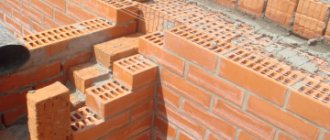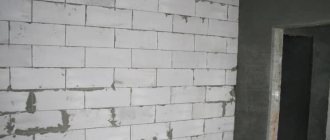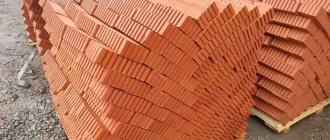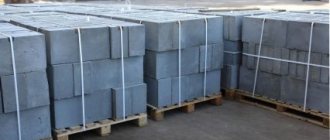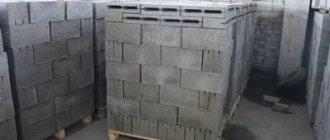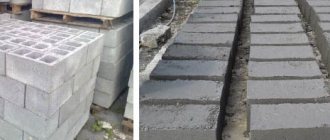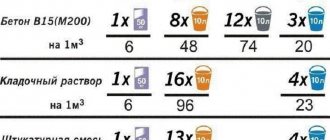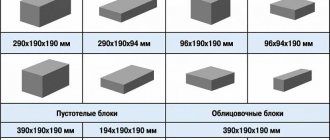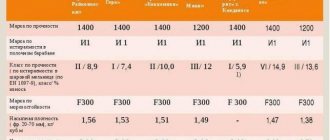To find out how many cinder blocks are in a cube, just perform a simple calculation. It is carried out before the start of work, when products are purchased individually or by cubic meters. Typically, cinder blocks are sold on pallets, the number and volume of which depends on the type of product and the weight of one unit of goods.
As part of a project for the construction of any facility, an estimate is developed that takes into account the volume of work. Brick and cinder block masonry in this case are measured in cubic meters. The number given in the document is not always an integer, which causes certain difficulties in calculation. Then it is necessary to determine the number of slag concrete blocks not only in 1m3, but also in 1m2, because Exterior and interior finishing is characterized by a different unit of measurement.
If the project is being developed by a construction company, you can turn to it for help. The specialists themselves will calculate how much material is needed and advise which store is best to contact. If you develop a construction project yourself, you will have to manually calculate the amount of required building materials. A construction estimate is most often a custom document drawn up by a specially trained person—an estimator. The estimate contains information not only about the scope of work, but also its cost. The latter is not the only correct one, because depends on many factors. In this case, when calculating cinder block masonry, the quality of cement introduced into the cement-sand mortar, the cost of additives, the presence of reinforcement, etc. are taken into account.
To calculate the amount of cinder block in 1 m³, you need to take into account several features:
- There are several types of slag concrete block, which differ in purpose and size, as a result of which its quantity varies in 1 m² and 1 m³. When using different types of products (facing, standard, partition) you will need different amounts of material.
- A slag concrete product consists of blast furnace slag, crushed cement, granulated screenings or crushed stone, and cement is used as a binder. The composition does not affect the amount of product in 1 cubic meter, but changes its mass. This should be taken into account when transporting the calculated amount of material to the work site. Also an important factor is the presence of voids in the product.
- Cinder concrete blocks can be made at home, in which case the dimensions may differ slightly from the dimensions of industrially produced products. Here it is necessary to take into account the average lengths of the sides of the building material in order to determine how many cinder blocks are in the cube.
- The dimensions of the standard block are 390x190x190 mm. When calculating, these dimensions increase slightly and are taken as 400x200x200 mm, this is due to the presence of a solution with a thickness of at least 10 mm between the blocks.
Why calculate the amount of cinder block in one square meter?
This initial stage of calculation is necessary to determine the exact amount of material required for the construction of a particular building. Thus, knowing the consumption per 1 sq. m., it is not difficult to calculate the total costs of the material. If a garage is being built with masonry in the floor of the block, the wall area of which is 51 square meters, this means that 663 cinder blocks need to be purchased. This amount will double if the building is built with walls 390 mm thick. In addition, you should always remember that the material should be purchased with a small reserve, taking into account possible defects or damage to the blocks directly during laying.
Why do you need to count the number of cinder blocks?
Having correctly calculated how many cinder blocks there are in a cube, you can move on to the economic part of construction, and calculate how many cubes of material will be required for the construction of the object under construction.
The specified formula for calculating the amount of building material in one cube is used for a wide variety of materials sold in cubic volumes. The formula allows you to calculate the required amount of materials for construction, accurate to one.
Considering the rather high cost of modern building materials, such a careful calculation of the number of cinder blocks required for construction is a mandatory and very important procedure that allows you to save the owner’s finances.
Cinder block is a building stone produced by artificial pressing or natural placement into a mold from a cinder concrete mixture. The standard dimensions of one unit are 400x200x400 mm. Such blocks are made both in industrial production and at home.
Fine crushed stone, broken brick, expanded clay, granite screenings, hardened cement scrap, broken glass and a number of other industrial wastes are used as filler. The binding material in the production of the material is cement.
This building material is universal, which is why the question is often asked: “How many cinder blocks are there in a cube?”, because today 80% of people starting construction tend to choose this material for the construction of their houses, barns, garages, sheds. It is used in almost all branches of construction.
Why do you need to know how many cinder blocks are in 1 cube? The volume of the walls is measured in m3. Therefore, in the house design they indicate that in the future there will be n blocks. This number is not always “round”. Therefore, in order not to make mistakes when purchasing, you need to calculate the exact amount of building materials based on your needs.
Specifications
What size cinder block do builders use?
The standard factory product has the following dimensions: When manufactured independently, the dimensions can be changed up to ± 5 mm, but it is better to adhere to the standards corresponding to the wall thickness modules used in masonry made of ordinary clay or sand-lime brick.
Cinder blocks can be solid or hollow. The volume occupied by voids can vary from 25 to 40%. Based on the number of voids that a cinder block contains, the weight of 1 piece is from 30 kg/piece. up to 15 kg/piece
Stones with greater hollowness, having a lower weight of cinder block, facilitate the work of laying them, have better thermal insulation properties, but their strength (grade) is lower than that of solid products.
System of measurements and calculations when choosing building materials
First of all, it should be noted that basic knowledge of subjects such as mathematics and geometry will help answer any question related to measurements and quantities. There are special formulas and calculation methods for this.
However, when asking the question of how many cinder blocks are in 1 cube, it is worth remembering that a unit of this material can have completely different sizes, which depend on its manufacturer.
How much material is in a cube when purchasing
- Before ordering a cinder block from the manufacturer, you need to clarify the dimensions of one unit of the product
. In the standard version they look like 40 cm x 20 cm x 20 cm, in length / width / height ratios. - Based on this, we can conclude that one block occupies a volume of 0.016 cubic meters. This is calculated by multiplying the length, height and width by each other, converting all values into meters.
- (0,4 * 0,2 * 0,2 = 0,016)
- Thus, in order to find out how much cinder block is in a cube, you need to divide 1 by 0.016.
- The result is a value equal to 62.5, but taking into account the fact that half of the product can not be counted, it comes out to 62.
However, it is worth noting that during transportation and installation of this material, its integrity is often violated. This is due to the fact that the cinder block is quite fragile and unstable to moisture. That is why the installation instructions recommend ordering cinder blocks with a 10% reserve.
How many meters of wall
Having decided how much a cube of cinder block costs and how many units there are in a given volume, you can determine the length and height of the future wall.
- To make such calculations, you need to know the height of the structure.
- As a guide, you can take the most optimal size of 2.5 meters.
- Next, approximately determining the thickness of the seam to be 1.5 cm.
- After this, we divide the wall height of 2.5 m by the block height of 0.2 m and in the end we get 7. This number will be equal to the number of rows.
- Then we divide the amount of cinder block in the cube by 7 and get the number 8.8, which will be equal to the number of units of material in the row. In this case, it is worth rounding this value to 8.
- Next, we multiply the quantity by the length of the material, and we get a wall with dimensions of 3.2 x 2.5 meters.
- (8 * 0,4 = 3.2)
- However, if you take into account the thickness of the seam, you can build a structure measuring 2.5 by 3.5.
However, it is worth noting that such calculations are very approximate.
Brick calculator
To simplify all construction calculations, a special program was invented called a brickwork calculator. Using it, you will not need to make calculations yourself, for which you just need to enter all the initial data, which will be processed and the corresponding result will be given.
The main feature of such a program is that it not only calculates the volume of masonry, but also takes into account the presence of windows and doorways. It can also work with any type of material, from ordinary bricks to blocks. In this case, such a calculator can take the thickness of the seams as the primary data, and display the amount of mortar as a result.
It is worth noting that the price of such a program is usually low, although there are also quite expensive versions installed on portable devices. However, on our website you can download it absolutely free.
